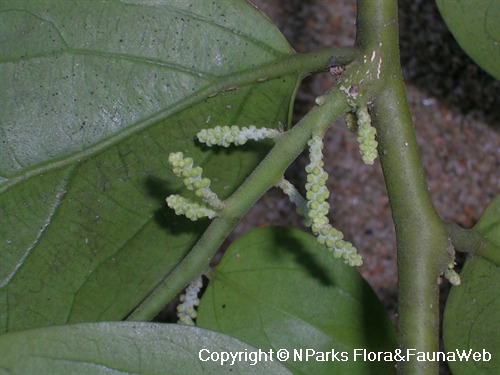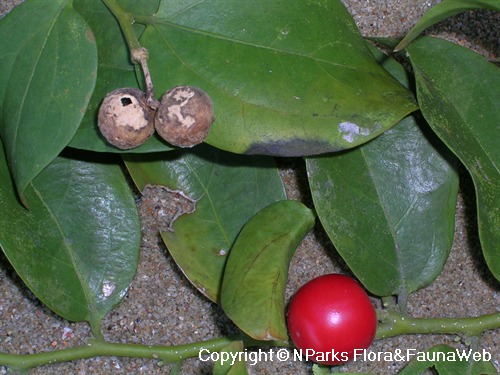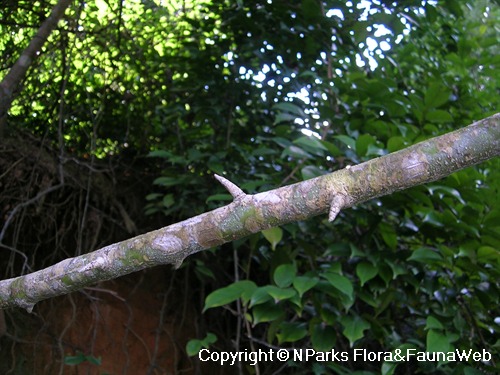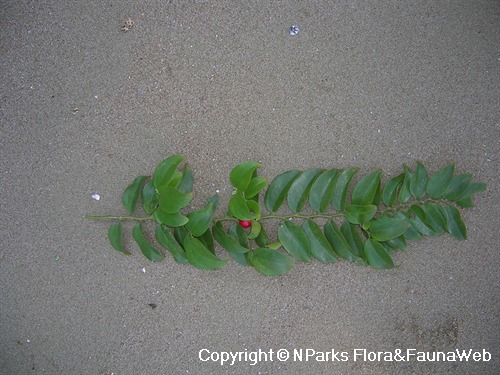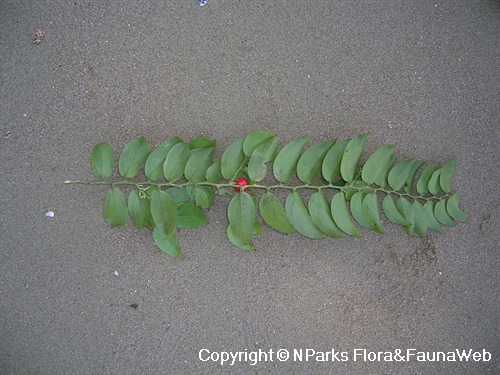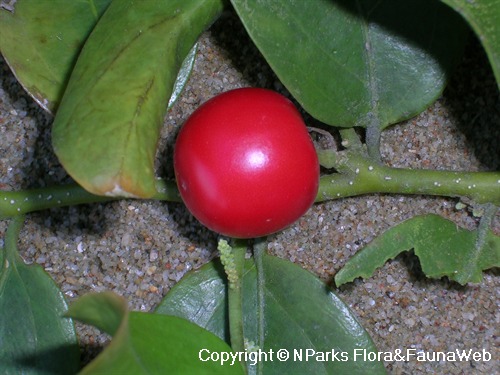
Back
Cansjera rheedei J.F.Gmel.
| Family Name: | Opiliaceae |
| Synonyms: | Cansjera zizyphifolia Griff., Cansjera rheedii J.F.Gmel. |
| Common Name: | 山柑藤 |
Name
Classifications and Characteristics
| Plant Division | Angiosperms (Flowering Seed Plants) (Dicotyledon) |
|---|---|
| Plant Growth Form | Climber |
| Lifespan (in Singapore) | Perennial |
| Mode of Nutrition | Autotrophic |
| Plant Shape | Irregular |
| Maximum Height | 11 m |
Biogeography
| Native Distribution | Nepal, India, Sri Lanka, south China, Sumatra, Peninsular Malaysia, Singapore, Borneo, and the Philippines |
|---|---|
| Native Habitat | Terrestrial (Primary Rainforest, Secondary Rainforest, Coastal Forest) |
| Preferred Climate Zone | Tropical, Sub-Tropical / Monsoonal |
| Local Conservation Status | Native to Singapore (Least Concern (LC)) |
Description and Ethnobotany
| Growth Form | It is a climber, up to 11 m long, with hanging branches, or an erect shrub with a spiny stem. |
|---|---|
| Foliage | Its leaves may or may not be stalked and have leathery leaf blades that are egg-shaped to lance-shaped or oval, hairless, and 5–9 by 1.5–4 cm. |
| Flowers | Its flowers (petals and sepals) are greenish-yellow, shaped like an urn, and 2.5–3 mm long. |
| Fruit | Its fruits are orange to red and 10–13 by 7–9 mm. |
| Habitat | It grows in deciduous and evergreen forests, often in beach forests, from sea level up to 1000 m altitude. |
| Associated Fauna | Its flowers are insect-pollinated. |
| Cultivation | It can be propagated by seed. |
| Etymology | Dutch Cansjera, abbreviation of the Malabar plant name, Tsieru cansjeram; Latin rheedii, named after Hendrik Adriaan van Rheede, a Dutch governor famous for his book on plants; Hortus Malabaricus |
Landscaping Features
| Landscaping | It is suitable for parks and gardens, on trellises and pergolas. |
|---|---|
| Desirable Plant Features | Ornamental Fruits |
| Landscape Uses | Coastal, Parks & Gardens, Trellis / Arbour / Pergola |
Fauna, Pollination and Dispersal
| Pollination Method(s) | Biotic (Fauna) |
|---|
Plant Care and Propagation
| Light Preference | Full Sun |
|---|---|
| Water Preference | Moderate Water |
| Plant Growth Rate | Fast to Moderate |
| Rootzone Tolerance | Moist Soils, Well-Drained Soils, Fertile Loamy Soils |
| Propagation Method | Seed |
Foliar
| Foliage Retention | Evergreen |
|---|---|
| Mature Foliage Colour(s) | Green |
| Mature Foliage Texture(s) | Leathery |
| Foliar Type | Simple / Unifoliate |
| Foliar Arrangement Along Stem | Alternate |
| Foliar Attachment to Stem | Petiolate, Sessile |
| Foliar Shape(s) | Non-Palm Foliage (Ovate, Oval, Lanceolate) |
| Foliar Venation | Pinnate / Net |
| Foliar Margin | Entire |
Floral (Angiosperm)
| Flower & Plant Sexuality | Bisexual Flowers |
| Flower Colour(s) | Green |
|---|---|
| Flower Grouping | Cluster / Inflorescence |
| Flower Location | Axillary |
Fruit, Seed and Spore
| Mature Fruit Colour(s) | Red |
|---|---|
| Fruit Classification | Simple Fruit |
| Fruit Type | Fleshy Fruit , Non-Accessory Fruit |
Image Repository
Others
| Master ID | 65 |
|---|---|
| Species ID | 1361 |
| Flora Disclaimer | The information in this website has been compiled from reliable sources, such as reference works on medicinal plants. It is not a substitute for medical advice or treatment and NParks does not purport to provide any medical advice. Readers should always consult his/her physician before using or consuming a plant for medicinal purposes. |

